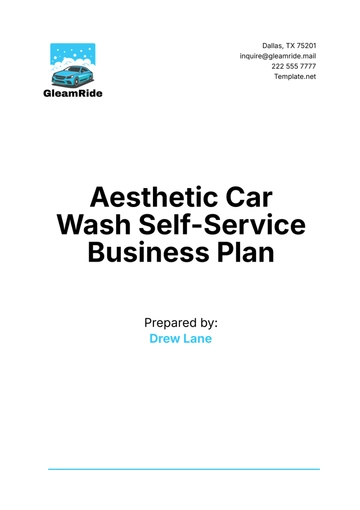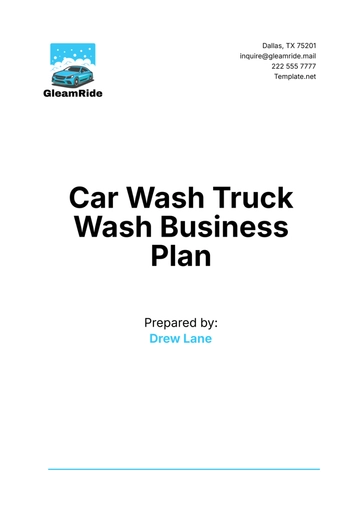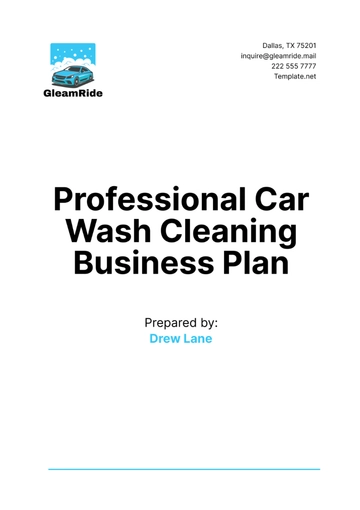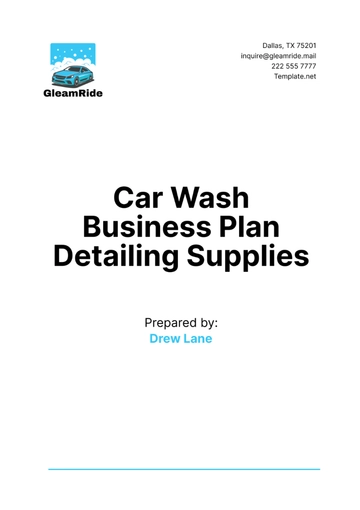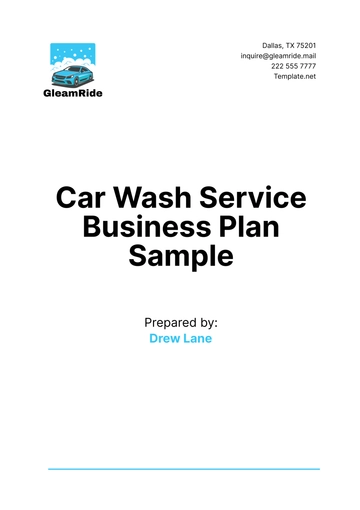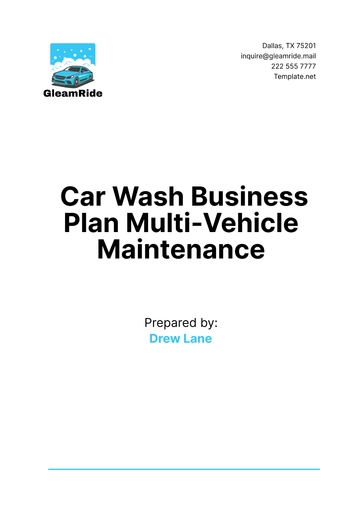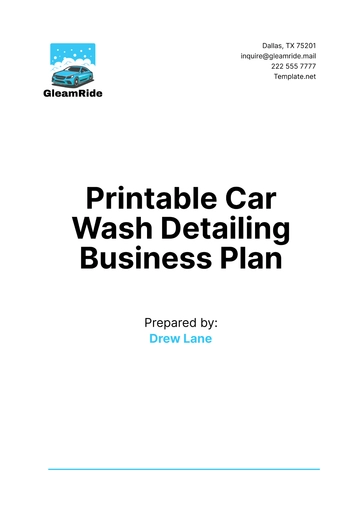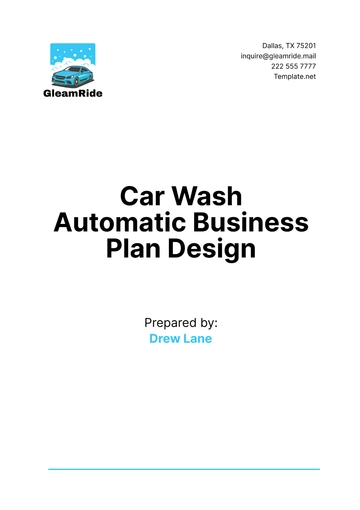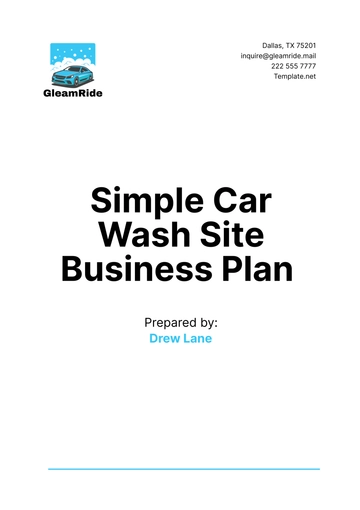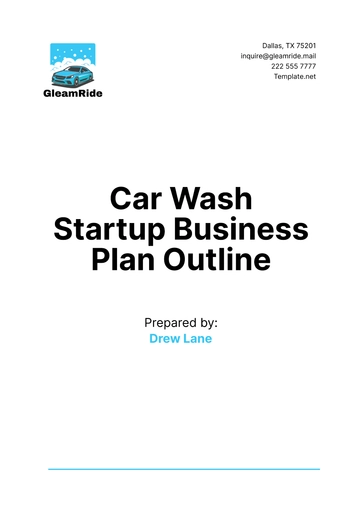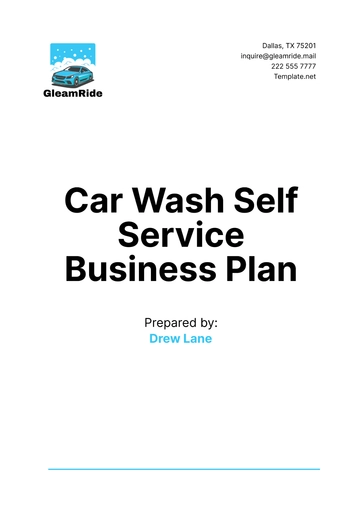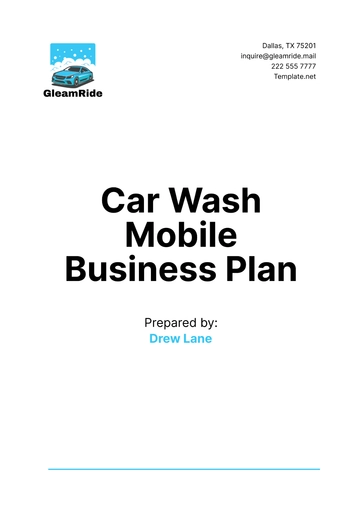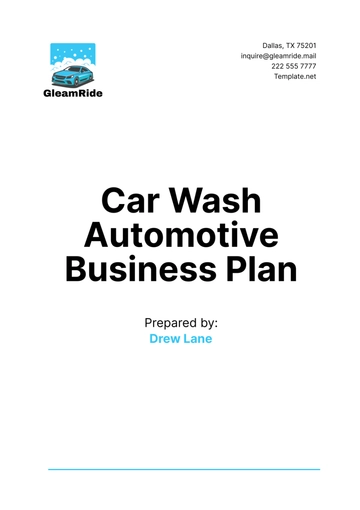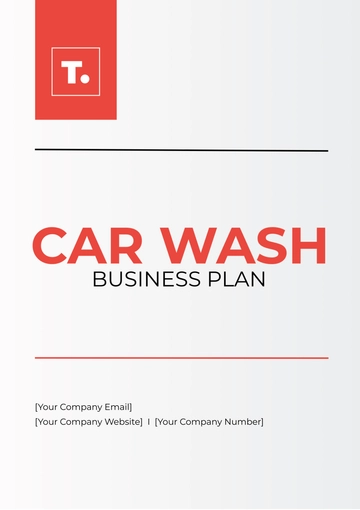Free Car Wash Mobile Business Plan
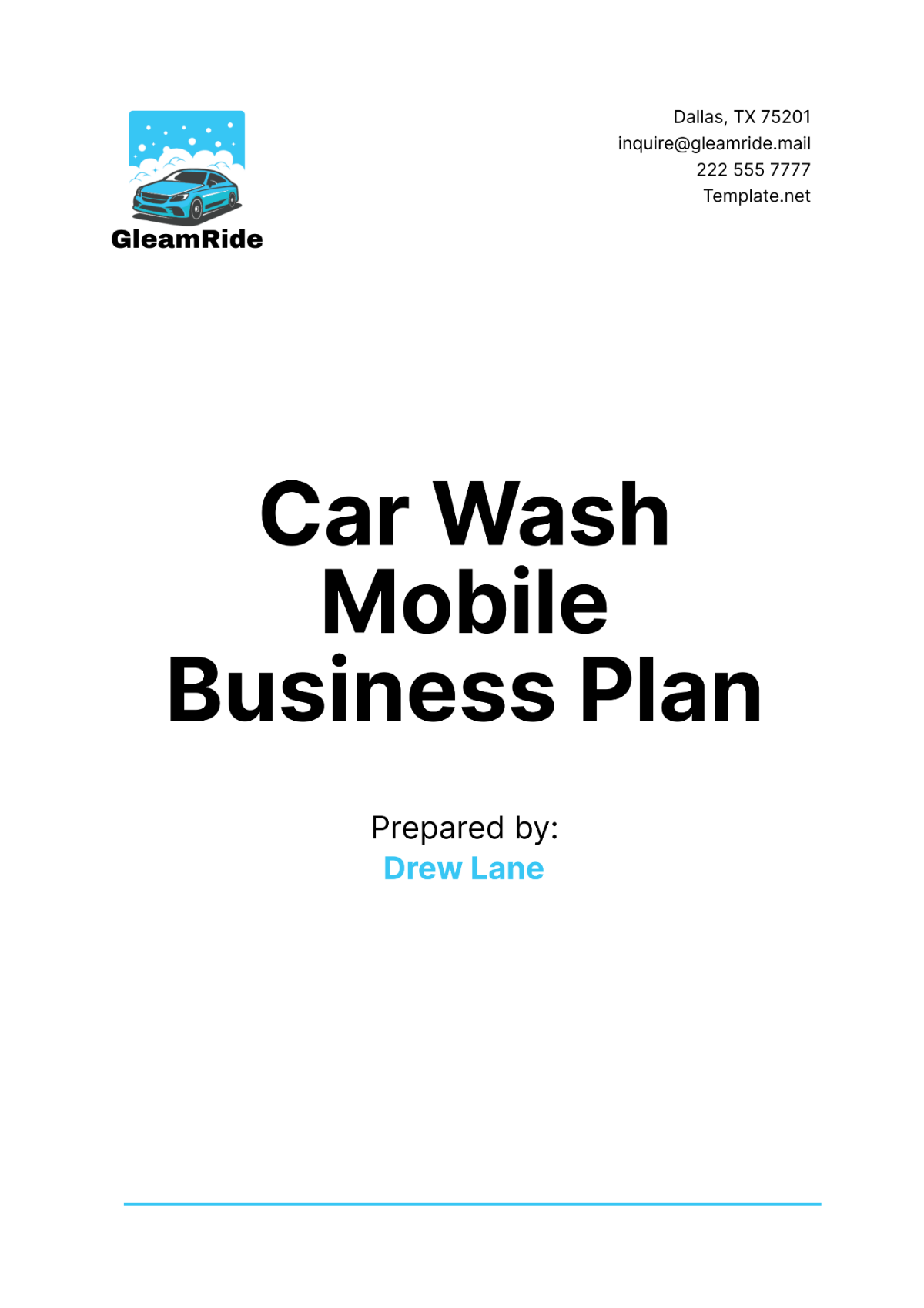
I. Executive Summary
[Your Company Name] aims to revolutionize the car wash industry by offering a convenient and eco-friendly mobile car wash service. The business will operate a fleet of fully equipped mobile units to provide high-quality car cleaning services at customers' locations. Our target market includes busy professionals, families, and businesses looking for convenient and efficient car wash solutions.
The initial investment for launching the mobile car wash service is estimated at $200,000, covering vehicle acquisition, equipment, marketing, and operational costs. We project reaching breakeven within the first year, with monthly revenues estimated at $50,000 by the end of the second year. Our competitive pricing, coupled with premium service offerings, will help us capture a significant market share.
This Car Wash Mobile Business Plan outlines our strategy to achieve these goals, detailing the market analysis, service offerings, operational plan, marketing strategy, financial projections, and risk management approach. Our comprehensive plan ensures a clear path to profitability and sustained growth in the mobile car wash industry.
II. Market Analysis
The following table provides an overview of the market analysis, highlighting key factors influencing the mobile car wash industry:
A. Market Size
Growing Demand: The demand for convenient car wash services is increasing as consumers seek time-saving solutions. This trend is driven by busy lifestyles and the need for hassle-free services.
High Impact: The growing market size offers a significant opportunity for our mobile car wash business to capture a large customer base. By providing on-demand services, we can tap into this expanding market.
B. Customer Demographics
Busy Professionals: Our primary target market includes busy professionals who value convenience and efficiency. These individuals are willing to pay a premium for time-saving services.
Families: Families with multiple vehicles and busy schedules also represent a significant customer segment. Our mobile service appeals to their need for convenience.
Businesses: Corporate clients and businesses with fleet vehicles will benefit from our mobile car wash services. Offering on-site services reduces downtime and improves operational efficiency.
C. Competitor Analysis
Few Competitors: The mobile car wash industry has few competitors offering similar services, providing us with a competitive advantage. Our unique value proposition sets us apart.
High Impact: The limited competition in the market allows us to establish a strong presence and build a loyal customer base. We can leverage our superior service quality to differentiate ourselves.
D. Economic Factors
Steady Economic Growth: A stable economy supports consumer spending on discretionary services like car washing. This positive economic environment is conducive to business growth.
Medium Impact: While economic factors play a role in consumer spending, the essential nature of car maintenance ensures consistent demand for our services.
E. Environmental Concerns
Eco-Friendly Practices: Increasing awareness of environmental concerns drives demand for eco-friendly car wash services. Our use of water-saving technologies and biodegradable products aligns with this trend.
High Impact: By positioning ourselves as an eco-friendly service provider, we can attract environmentally conscious customers and build a positive brand image.
III. Service Offerings
The following table outlines our core service offerings, including a description and pricing for each service:
No. | Service | Description | Pricing |
|---|---|---|---|
1 | Basic Wash | Exterior wash, rinse, and dry | $25 |
2 | Full Service Wash | Basic wash plus interior vacuum and wipe-down | $50 |
3 | Deluxe Wash | Full service wash plus waxing and tire cleaning | $75 |
4 | Fleet Service | Customized packages for business fleets | $200/month per car |
5 | Eco-Friendly Wash | Full service using eco-friendly products | $60 |
A. Basic Wash
Exterior Wash: The basic wash includes a thorough exterior cleaning, ensuring that the vehicle is free from dirt and grime. This service is ideal for regular maintenance.
Rinse and Dry: After washing, the vehicle is rinsed and dried to prevent water spots and streaks. This step ensures a spotless finish.
B. Full Service Wash
Interior Vacuum: In addition to the exterior wash, the full service includes vacuuming the interior to remove dirt and debris. This service provides a comprehensive clean.
Wipe-Down: Interior surfaces are wiped down to remove dust and fingerprints, leaving the vehicle looking fresh and clean.
C. Deluxe Wash
Waxing: The deluxe wash includes waxing the exterior to provide a protective layer and enhance the vehicle's shine. Waxing also helps preserve the paint.
Tire Cleaning: Tires are cleaned and dressed to give them a polished look. This service ensures the entire vehicle looks well-maintained.
D. Fleet Service
Customized Packages: We offer tailored packages for businesses with multiple vehicles. Fleet services ensure that all company cars are consistently clean and presentable.
Monthly Pricing: Our competitive monthly pricing per car makes it affordable for businesses to maintain their fleet. Regular cleaning enhances the company's professional image.
E. Eco-Friendly Wash
Biodegradable Products: The eco-friendly wash uses biodegradable cleaning products that are safe for the environment. This service appeals to environmentally conscious customers.
Water-Saving Techniques: Our eco-friendly wash employs water-saving techniques to reduce water usage. This approach aligns with our commitment to sustainability.
IV. Operational Plan
The following table outlines the operational plan for our mobile car wash business, including key activities and timelines:
No. | Activity | Description | Timeline |
|---|---|---|---|
1 | Vehicle Acquisition | Purchase and equip mobile units | Months 1-2 |
2 | Staff Hiring | Recruit and train car wash technicians | Months 1-3 |
3 | Marketing Campaign | Launch initial marketing and promotional efforts | Months 2-4 |
4 | Service Launch | Commence operations and service delivery | Month 4 |
5 | Customer Feedback | Collect and analyze customer feedback for improvement | Ongoing |
A. Vehicle Acquisition
Purchase Mobile Units: Acquire vehicles specifically designed for mobile car wash services. These units will be equipped with the necessary tools and equipment.
Equip Vehicles: Outfit the vehicles with water tanks, pressure washers, vacuum cleaners, and other essential tools. Properly equipped units ensure efficient service delivery.
B. Staff Hiring
Recruit Technicians: Hire experienced car wash technicians who are skilled in both exterior and interior cleaning. Skilled staff are crucial for delivering high-quality services.
Training Program: Implement a comprehensive training program to ensure all technicians are proficient in our service standards and eco-friendly practices.
C. Marketing Campaign
Digital Marketing: Launch digital marketing campaigns to raise awareness of our services. Utilize social media, search engine optimization (SEO), and online advertising.
Promotional Offers: Introduce special offers and discounts to attract initial customers. Promotions help generate interest and build a customer base.
D. Service Launch
Operational Readiness: Ensure all mobile units and staff are ready for service delivery. Conduct a final check to confirm that all systems are operational.
Customer Appointments: Begin scheduling and fulfilling customer appointments. Efficient scheduling maximizes service capacity and customer satisfaction.
E. Customer Feedback
Feedback Collection: Collect feedback from customers through surveys and direct communication. Feedback provides valuable insights into service quality and areas for improvement.
Analyze Feedback: Regularly analyze customer feedback to identify trends and make necessary adjustments. Continuous improvement enhances customer satisfaction.
V. Budget Allocation
The following chart and table outline the budget allocation for the initial setup and operational costs of the mobile car wash business:
No. | Expense | Amount |
|---|---|---|
1 | Vehicle Acquisition | $100,000 |
2 | Equipment Purchase | $50,000 |
3 | Staff Recruitment | $20,000 |
4 | Marketing Campaign | $20,000 |
5 | Operating Expenses | $10,000 |
Total | $200,000 |
A. Vehicle Acquisition
Purchase Cost: Allocate $80,000 for purchasing vehicles designed for mobile car wash services. These vehicles will serve as the foundation of our operations.
Customization: Set aside $20,000 for customizing the vehicles with necessary equipment and branding. Customization ensures that the vehicles are fully functional and visually appealing.
B. Equipment Purchase
Cleaning Equipment: Allocate $30,000 for purchasing high-quality cleaning equipment, including pressure washers, vacuum cleaners, and water tanks. Quality equipment ensures efficient service delivery.
Supplies: Budget $20,000 for purchasing cleaning supplies such as soaps, waxes, and biodegradable products. Adequate supplies are essential for maintaining service standards.
C. Staff Recruitment
Recruitment Costs: Allocate $10,000 for recruiting skilled car wash technicians. Recruitment efforts include job advertisements, interviews, and background checks.
Training Program: Set aside $10,000 for implementing a comprehensive training program for new hires. Training ensures that all staff are proficient in our service standards.
D. Marketing Campaign
Digital Marketing: Allocate $15,000 for digital marketing efforts, including social media advertising and SEO. Digital marketing raises awareness and attracts customers.
Promotional Materials: Budget $5,000 for creating promotional materials such as flyers, brochures, and banners. Promotional materials support marketing efforts.
E. Operating Expenses
Fuel Costs: Allocate $5,000 for fuel expenses to operate the mobile units. Efficient fuel management is crucial for minimizing operating costs.
Miscellaneous Expenses: Set aside $5,000 for miscellaneous expenses such as vehicle maintenance and office supplies. A buffer for unexpected costs ensures smooth operations.
VI. Marketing Strategy
The following table outlines the key components of our marketing strategy, including objectives, target audience, and tactics:
No. | Component | Objective | Target Audience | Tactics |
|---|---|---|---|---|
1 | Brand Awareness | Increase awareness of [Your Company Name] | General Public | Social Media, SEO |
2 | Customer Acquisition | Attract new customers | Busy Professionals | Online Ads, Promotions |
3 | Customer Retention | Retain existing customers | Existing Customers | Loyalty Programs, Email |
4 | Corporate Clients | Secure business clients | Businesses | B2B Marketing, Referrals |
A. Brand Awareness
Social Media: Utilize social media platforms to build brand awareness and engage with potential customers. Regular posts, ads, and interactions increase visibility.
SEO: Optimize our website for search engines to ensure we appear in relevant search results. Effective SEO attracts organic traffic and increases brand recognition.
B. Customer Acquisition
Online Ads: Launch targeted online advertising campaigns to attract busy professionals seeking convenient car wash services. Ads on platforms like Google and Facebook reach our target audience.
Promotions: Offer special promotions and discounts to incentivize first-time customers. Promotions encourage trial and help build a customer base.
C. Customer Retention
Loyalty Programs: Implement a loyalty program to reward repeat customers with discounts and perks. Loyalty programs enhance customer satisfaction and retention.
Email Marketing: Use email marketing to stay connected with existing customers. Regular updates, offers, and service reminders keep customers engaged.
D. Corporate Clients
B2B Marketing: Develop targeted marketing strategies to attract corporate clients and businesses with fleet vehicles. B2B marketing focuses on the benefits of our services for businesses.
Referrals: Encourage satisfied customers to refer our services to other businesses. Referral incentives motivate customers to spread the word about our services.
VII. Financial Projections
The following chart and table provide the overview of our financial projections for the first three years of operation:
Year | Revenue | Expenses | Net Profit |
|---|---|---|---|
2051 | $400,000 | $300,000 | $100,000 |
2052 | $600,000 | $350,000 | $250,000 |
2053 | $800,000 | $400,000 | $400,000 |
A. Revenue Projections
2051: We project generating $400,000 in revenue in the first year by capturing a significant share of the market through aggressive marketing and high-quality services.
2052: Revenue is expected to increase to $600,000 in the second year as we expand our customer base and introduce new services. Continued marketing efforts drive growth.
2053: By the third year, we anticipate reaching $800,000 in revenue, supported by a loyal customer base and increased brand recognition. Diversified service offerings contribute to higher sales.
B. Expense Projections
2051: Initial expenses of $300,000 cover vehicle acquisition, equipment purchase, marketing, and operational costs. Efficient cost management is crucial for profitability.
2052: Expenses rise to $350,000 in the second year due to increased marketing efforts and operational scaling. Continued investment in quality and efficiency drives growth.
2053: Expenses reach $400,000 in the third year as we expand our fleet and services. Sustainable growth is maintained through strategic investments.
C. Net Profit Projections
2051: We project a net profit of $100,000 in the first year, reflecting our efficient cost management and successful market entry. Early profitability sets a strong foundation.
2052: Net profit increases to $250,000 in the second year, driven by higher revenue and controlled expenses. Positive cash flow supports business expansion.
2053: By the third year, net profit is projected to reach $400,000, demonstrating sustained growth and profitability. Our comprehensive business strategy ensures long-term success.
VIII. Risk Management
The following table outlines potential risks and mitigation strategies to ensure the stability and success of our mobile car wash business:
No. | Risk | Description | Mitigation Strategy |
|---|---|---|---|
1 | Market Competition | New competitors entering the market | Differentiation, Quality |
2 | Economic Downturn | Reduced consumer spending during economic slowdowns | Diversified Services |
3 | Operational Challenges | Vehicle maintenance or staff turnover | Preventive Maintenance, Training |
4 | Regulatory Changes | New regulations affecting mobile services | Compliance Monitoring |
A. Market Competition
New Competitors: The entry of new competitors into the mobile car wash market could affect our market share. To mitigate this risk, we focus on differentiating our services through superior quality and customer experience.
Quality Assurance: Maintaining high service quality and continuously improving our offerings will help us retain customers and attract new ones, even in a competitive market.
B. Economic Downturn
Reduced Spending: Economic downturns may lead to reduced consumer spending on discretionary services like car washing. To mitigate this risk, we diversify our service offerings to include essential and value-added services.
Customer Retention: Implementing loyalty programs and offering flexible pricing options will help retain customers during economic slowdowns. Consistent communication and promotions keep customers engaged.
C. Operational Challenges
Vehicle Maintenance: Operational challenges such as vehicle maintenance issues can disrupt service delivery. We implement a preventive maintenance program to ensure all vehicles are in optimal condition.
Staff Turnover: High staff turnover can impact service quality. Comprehensive training programs and employee engagement initiatives help retain skilled technicians.
D. Regulatory Changes
Compliance Monitoring: Staying informed about regulatory changes affecting mobile services is crucial. We establish a compliance monitoring system to ensure all operations adhere to relevant regulations.
Adaptability: Our business model is designed to be adaptable, allowing us to quickly adjust to new regulations and maintain compliance. Regular training updates ensure staff are aware of regulatory requirements.
IX. Conclusion and Next Steps
A. Conclusion
[Your Company Name] is well-positioned to capitalize on the growing demand for convenient and eco-friendly car wash services. Our Car Wash Mobile Business Plan outlines a clear path to profitability and sustained growth, supported by detailed market analysis, service offerings, operational plan, marketing strategy, financial projections, and risk management approach. By focusing on quality, convenience, and sustainability, we aim to establish a strong presence in the mobile car wash industry and build a loyal customer base.
Our financial projections indicate significant growth potential, with revenue expected to reach $800,000 by the third year and net profit projected at $400,000. This success will be driven by our commitment to customer satisfaction, innovative service delivery, and strategic marketing efforts. We are confident that our business model will thrive in the competitive landscape and deliver long-term value to our stakeholders.
B. Next Steps
The following next steps outline the key actions to be taken to implement our mobile car wash business plan:
Finalize Vehicle Acquisition: Complete the purchase and customization of mobile units to ensure they are equipped and branded for service delivery.
Recruit and Train Staff: Hire experienced car wash technicians and implement a comprehensive training program to ensure all staff are proficient in our service standards.
Launch Marketing Campaign: Execute the initial marketing campaign to raise awareness and attract customers through digital marketing and promotional offers.
Commence Operations: Begin scheduling and fulfilling customer appointments, ensuring efficient and high-quality service delivery.
Collect Customer Feedback: Implement a feedback collection system to gather insights from customers and continuously improve our services.
Monitor Financial Performance: Regularly review financial performance to track revenue, expenses, and profitability, making adjustments as necessary to achieve growth targets.
Stay Informed on Regulations: Establish a compliance monitoring system to stay informed about regulatory changes and ensure all operations adhere to relevant requirements.
Expand Service Offerings: Explore opportunities to expand service offerings and introduce new value-added services to attract and retain customers.
Evaluate Business Performance: Conduct regular evaluations of business performance against key performance indicators (KPIs) to identify areas for improvement and drive continuous growth.
- 100% Customizable, free editor
- Access 1 Million+ Templates, photo’s & graphics
- Download or share as a template
- Click and replace photos, graphics, text, backgrounds
- Resize, crop, AI write & more
- Access advanced editor
Generate an effective plan for your mobile car wash service using the Car Wash Mobile Business Plan Template on Template.net! This customizable template offers a comprehensive layout for your business plan. The editable sections make it easy to personalize the content. Utilize the AI Editor Tool to enhance your planning!
You may also like
- One Page Business Plan
- Coffee Shop Business Plan
- Restaurant Business Plan
- Food Business Plan
- Real Estate Business Plan
- Executive Summary Business Plan
- Cover Page Business Plan
- Nonprofit Business Plan
- Daycare Business Plan
- Construction Business Plan
- Startup Business Plan
- Medical Business Plan
- Bakery Business Plan
- Service Plan
- Hotel Business Plan
- Catering Business Plan
- School Business Plan
- Healthcare Business Plan
- Transportation Plan
- Sports Plan
- Car Wash Business Plan
- Salon Business Plan
- Clothing Business Plan
- Farming Business Plan
- Boutique Plan


